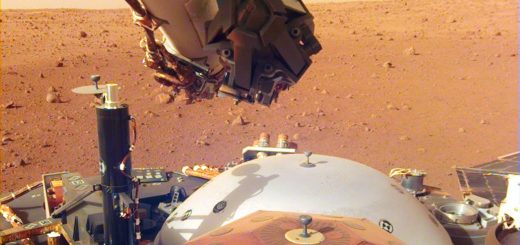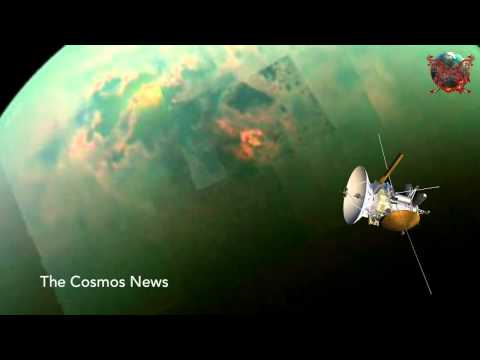NASA’s Dragonfly Mission to Titan
This episode of Real Engineering is broughtto you by Brilliant, a problem solving websitethat teaches you to think like an engineer. Over the last 100 years, advancements in scienceand technology have allowed us to learn somuch about where we came from and how ourplanet has developed over time. With our discoveries of old fossils, we knowthat life on Earth has existed for at least3. 5 billion years. But with the Earth itself believed to haveformed about 4. 5 billion years ago, we stillhave very limited knowledge on what causedlife to form in the first place, and muchof the evidence on how it may have developedhas actually been destroyed by the very lifethat it created. Sadly, we don’t have a time machine, butwe can look for places in our solar systemthat emulate early earth. That’s where Saturn’s largest Moon ‘Titan’comes into the picture. Although it’s about half the size of Earth,Titan has the characteristics that we thinkare very similar to Earth in its early days. Titan has a thick atmosphere at around 4. 4times denser than Earth’s, and is the onlyMoon in the solar system to have any noticeableatmosphere at all . Titan also has large pools of liquid whichfollow a similar cycle to the rivers and seaswe have here on Earth. But, instead of water, Titan has seas of methanewhich evaporate into clouds, causing it torain liquid methane. In terms of scientific information, Titanis a gold mine for scientists. But sadly, it’s extremely difficult to getto and because it’s entirely covered inclouds of methane, it’s nearly impossibleto study the surface from a distance . In 1997, a collaboration between NASA, theEuropean Space Agency and the Italian SpaceAgency launched the Cassini space probe ona 7 year journey to reach Saturn. The probe was designed to study the entireSaturn system including its rings and naturalsatellites. But Cassini didn’t make the 7 year journeyon its own. Attached to the space probe was a small landercalled Huygens which was hoping to becomethe first spacecraft to land on Titan. Several months after entering Saturn’s orbit,Huygens separated from Cassini and startedits journey towards Titan . And began sending back vital details aboutTitan’s environment, like the fluid propertiesof the atmosphere and the nature of the moon’ssurface. As it descended Huygens recorded accelerometerdata, which could be used to deduce propertieslike density of the fluid as we knew the aerodynamicproperties of the probe. It took temperature and pressure readingsto teach us about the thermodynamic propertiesof the atmosphere. After two and a half hours of descendingthrough the unknown, Huygens successfullylanded on the surface, making it the furthestspacecraft landing from Earth ever completed. Although it was only designed to survive forabout 90 minutes whilst on the surface, Huygenssuccessfully recorded and sent back 350 images,revealing a world eerily similar to ours,with sharp hills and valleys, and rivers ofmethane cutting their way through the landscape. . As our quest to learn more about the originsof life continues, Nasa’s new mission called‘Dragonfly’ will begin its journey toTitan in 2026, and the work of the Cassiniand Huygen mission will be vital to its success. Dragonfly is a mobile lander fitted with 8large rotors that will help it fly aroundthe surface like a drone. An incredible difficult engineering challenge,and the data gained from Huygens will be insanelyvaluable when designing the drone. Everything from it’s sensor layout, batterycapacity, energy source and propellers designwill be dictated by what we learned, and thoseare exactly the engineering challenges weare going to investigate today. Dragonfly will have many of the same scientificinstruments as the curiosity rover. It will have skid mounted drill to take soilsamples and run it through a mass spectrometerto learn more about the soil composition. It will be capable of quickly analysing elementalcompositions at landing sites before landing,using a neutron-activated gamma-ray spectrometer. This instrument typical needs cryocooling,but thanks to Titan’s subzero temperatures,this instrument can be passively cooled. It will however need to generate its own neutron’srather relying on cosmic rays to generatethem, as the 0atmosphere blocks too much sunlight. When it lands a seismometer will give us informationabout quakes and reveal the thickness andnature of Titan’s icy crust sitting abovewhat is thought to be liquid water ocean. We think this because Cassini witnessed thesurface shifting in position by 30 kilometersin just 2 years, indicating that the crustis floating on top of some kind of liquidlayer. We can also look forward to incredible photosof Titan’s surface, just like the photoswe are currently getting from Mars. Since the air is thicker on Titan and thegravity is one sevenths of earth’s, dragonflywill be able to achieve more thrust on a planetthat needs less lift. Drastically reducing energy consumption comparedto earth. Yet finding that energy to fly on the surfaceof Titan is not easy. Due to Titan’s distance from the Sun andits thick atmosphere, the sunlight on Titan’ssurface is around 100 times weaker than itis on Earth, making solar panels impractical. Thankfully we have a lot of practice in adifferent type of energy source through missionslike the Curiosity Rover, which was poweredby Radioisotope Thermoelectric Generator. RTG’s work by converting the heat from thenatural decay of a radioisotope into electricity. Now this isn’t traditional nuclear energylike I have mistakenly said in the past. The RTG does use radioactive materialsto generate electricity, but not through nuclearfission. It uses a simple principle called the SeebeckEffect to generate electricity. The seebeck effect essentially allowsus to generate an electric current througha heat differential, as charge carriers willmove from hot to cold. So if we have a heat source and a way of coolingwe can generate a sustained electric current. Thankfully radioactive substances generateheat as they decay. Choosing a suitable radioactive material isour first challenge. With any spacecraft a lightweight compactdesign is paramount, but we also need thematerial to have a long half life to ensurea long lived energy source. We also need it to primary produce Alpha waves,as this form of radiation is most easily convertedto heat in a compact space. As a result of these requirements Plutonium-238 , Strontium-90 , and Curium-244are the most commonly used fuels. Next we need a material which is both a thermalinsulator to maximise our temperature differential,and an electric conductor to maximise ourcurrent. These two material properties are typicallinked. Materials like copper are both a good thermaland electrical conductor, and a material likeiron is a poor thermal and electrical conductor. Using these materials in conjunction can createa crude thermoelectric generator, but theefficiency is very low. If we can create a material with the bestof both properties, then we can achieve ahigher efficiency. Leading to the use of materials like leadtelluride and tags, which is an alloy of Tellurium , Silver , Germanium and Antimony . The thermal electric generator used for thecuriosity rover could generate 110 Watts ofelectrical power. But we will lose somepower generation capability during Dragonfly’s8 year journey to Titan, as we cannot turna radioactive element on and off on demandto conserve energy. In fact Dragonfly’s cruise vehicle willneed to be equipped with radiators to bleedthat heat energy into space to prevent overheating,just as the Curiosity rover did. We will also lose energy to keeping the craftat operating temperature, as the surface ofTitan can reach temperatures as low as -180°C, and to keep some vital systems and scientificexperiments running, leaving us with about75 watts to charge while on the ground ina best case scenario. All of our activities will occur during Titan’sdaylight hours, so we will be aiming to chargeour batteries during Titan’s nights, whichlasts 192 hours, the same as their daylighthours. So, it makes sense to make our battery chargefully in those 192 hours. Giving us a 14 kWh battery. For comparison, a typical tesla battery isabout 75 kWhs. With a specific energy of 100 Wh/kg, thatwill make our battery 140 kilograms. In practice a smaller battery will probablybe used, and even a 30 kilogram 3 kWh batterywould provide up to 2 hours of flight timeat 10 m/s, providing a massive 72 kilometrerange. Even more incredible when you consider theCuriosity Rover has only driven 21 kilometresover the past 7 years of its time on Mars. Ofcourse, Dragonfly won’t fly it’s maximumrange in one hop and will likely take shortersafer hops between interesting points duringTitan’s day and one of the most impressivethings about this mission is how the spacecraftwill navigate its way around the surface. Since Titan is so far from Earth, just sendingbasic information to Earth and from Earthwill be difficult. The energy requirements to transmit data risesdramatically as a result of the inverse squarelaw. The Huygen probe had the advantage ofbeing able to relay information to the Cassinispace probe, which had a larger antenna andhigher power. Unfortunately for the Dragonfly mission, Cassiniis no longer in orbit around Saturn fallinginto Saturn’s atmosphere in 2017. So Dragonfly will need to dedicate bothprecious power and weight to a large high-gainantenna in order to communicate with Earth’sDeep Space Network. On top of the additional energy and weightrequirements,Titan B-Roll The average round trip communication timeis around 2 and a half hours, making it impossibleto fly the spacecraft in real time. Instead Dragonfly with fly using its own vision,much like the self flying drones we have hereon Earth, Dragonfly will use its cameras alongwith the onboard gyroscopes and accelerometersto travel from one point to another. Dragonfly will be trained to identify suitablelanding sites that are flat and free fromany obstacles like large rocks and rough terrain. Originally, Dragonfly was intended to flywith a single rotor, but since helicoptersare mechanically complex in the way they varythe rotor’s pitch to vary lift, the ideawas never developed. But with the surge in multi-rotor dronetechnology over the last decade, the ideafor a quadcopter became much more feasible. Dragonfly will feature a total of 8 rotorsmounted in pairs in a quadcopter layout. Unlike a helicopter rotor—which is designedto spin at a constant rate—the speed ofeach rotor can been throttled electricallyto vary the amount of lift generated. Although its less efficient to have rotorsin this over-under configuration comparedto a regular quadcopter, it does provide additionallift while giving some redundancy, as theaircraft will be able to achieve stable flighteven with the loss of one motor or rotor. . Since Titan’s atmosphere is made up of mostlyNitrogen and is much colder than Earth’satmosphere, the viscosity is also much lower. Along with the higher density, this meansthat the rotors on Dragonfly will be operatingin a fluid with a much higher Reynolds numberthan they would if they were operating onEarth. Reynolds number is essentially a quantitythat informs engineers whether laminar orturbulent flow will develop. It’s a little confusing as the number isnot constant for every situation and dependslargely on the application, but in generalit can be described by this equation for flowin a pipe. Where inertial forces, trying to keep thefluid flowing, are the numerators, and viscousforces, trying to slow down the fluid, arethe denominator. Here a higher density will increase reynoldsnumber and thus increase the likelihood ofturbulent flow, and a lower viscosity willalso increase it. Exactly the scenario we are encountering onTitan. As a result, the propellers had to be designeddifferently to work as efficiently as possibleon Titan. They are in fact much closer in design towind turbine blades than normal propellers,with a large amount of twist in the aerofoil. These propellers are a metre in diameter,much smaller than any wind turbine blade hereon earth, but as a result of that higher reynoldsnumber the same design principles are applicable. Wind turbines are also designed to be resistantto a build up of surface dirt, which willbe a valuable property on another planet withmaintenance crews billions of kilometres away. We also need to factor in the lower speedof sound on Titan, which is about 194 m/sversus 340 m/s, so shock wave formation canoccur much sooner at the tips of our propellers. This means we have to be mindful of tip speedswhich are determined by prop diameter androtational speed. Even with these unique environmental factorsDragonfly will have a mass of around 450kgwith fantastic range and max speed. Allowing Dragonfly to first land in the sanddunes of Titan’s Equatorial region beforeeventually making it’s way to Selk Crater,an impact crater thought to contain all thebuilding blocks of life that we are familiarwith here on earth, and may just give us someclues about Human’s ultimate question. How did we get here. You may have noticed that I mentioned theinverse square law, but did not fully explainit. This is a law that applies to a huge numberof physical properties and it simply statesthat the intensity of a point source of energywill decrease with the square of the distanceaway from it. This applies to gravity, electric fieldsand radiation like the dragonfly trying tosend radio waves back to earth. To learn more about it you could take thiscourse in gravitational physics to learn howNewton deduced that the force of gravity obeysthe inverse-square law, and help you understandsome of the terms I use in my videos. This is just one small chapter in a courseon Brilliant, and you can choose from manyother courses to test your brain and learnmore about our universe. Or you could complete one of Brilliant’sdaily challenges. Each day Brilliant presents with you withinteresting scientific and mathematical problemsto test your brainEach Daily challenge provides you with thecontext and framework that you need to tackleit, so that you learn the concepts by applyingthem. If you like the problem and want to learnmore, there’s a course quiz that exploresthe same concept in greater detail. If you are confused and need more guidance,there’s a community of thousands of learnersdiscussing the problems and writing solutions. Daily challenges are thought provoking challengesthat will lead you from curiosity to masteryone day at a time. If I have inspired you and you want to educateyourself, then go to brilliant. org/RealEngineeringand sign up for free. And the first 500 peoplethat go to that link will get 20% off theannual Premium subscription, so you can getfull access to all their courses as well asthe entire daily challenges archive. As always, thanks for watching and thank youto all my Patreon supporters. If you would like to see more from me thelinks to my instagram, twitter, subredditand discord server are below.














